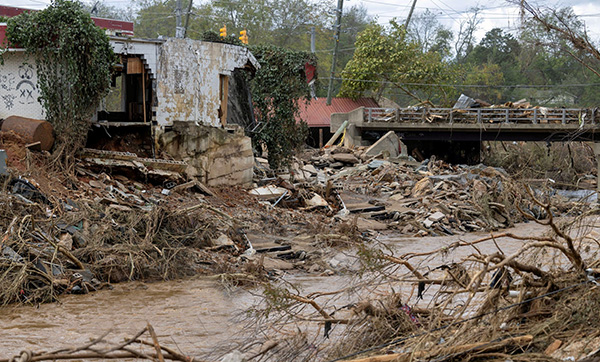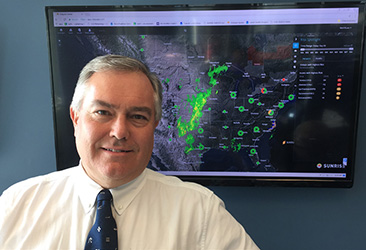Volume 28 | Issue 2
By Jon Davis, Chief Meteorologist, Everstream Analytics Weather & Climate Team
Click here to read the complete illustrated article or continue below to read the text article.
In September 2024, Hurricane Helene swept through the southeastern US, leaving a trail of devastation behind it. Entire towns were washed off the map in a matter of hours. Communities that had stood for generations were reduced to rubble. The images that emerged in the aftermath were immediate, visceral and heart-wrenching.
But while floods like those from Helene command attention with their sudden violence and immediate impact, a slower-moving crisis is unfolding across other parts of the world: one that doesn’t make for dramatic footage but is just as dangerous. Drought is a more insidious threat. Lacking a singular moment of impact, it creeps in gradually, sapping moisture from the soil, straining water systems, and weakening food and energy production over time. When conditions one day are just a little bit worse than the day before, it’s hard to drive headlines. Stack a couple thousand of those days on top of each other, though, and it adds up.
By the time the consequences become clear – diminished (or failed) crop yields, power shortages, empty reservoirs – the damage is already done. Sure, it’s not as visually arresting as the “here today, gone tomorrow” images that come with floods, but make no mistake: the drought is among the most disruptive forces facing global commerce today.
The first half of 2025 has already shown signs that this will be a defining year for drought-driven supply chain disruption. As the Northern Hemisphere enters summer, a critical season for crop development and water consumption, the warning signs are hard to ignore. From farmland in Brazil to riverbeds in Europe and reservoirs in the U.S. and Mexico, drought conditions are tightening their grip on global production networks. And with climate and weather patterns working against farmers and industries alike, the risks are mounting.

There are indications that we are entering an era of fragile food security. As planting season ramps up across the Northern Hemisphere widespread dryness, aggravated by long-term climate cycles like La Niña and the negative Pacific Decadal Oscillation (-PDO), is making 2025 look increasingly like a year of increased risk of crop stress in various major growing areas.
Drought conditions in the Americas have reached their highest level in more than two decades. These conditions are especially pronounced in Brazil, one of the world’s most important agricultural exporters. In the south- eastern states of São Paulo, Paraná, and Minas Gerais, regions that account for significant production of coffee, sugar cane, and citrus, soil moisture levels have consistently been in the lower end of the historical distribution. These are not minor fluctuations; current moisture levels fall within the bottom 15 percent of all years since 1948.
These increasingly dry conditions are being felt across the globe. Have you noticed coffee prices ticking higher? Brazil is the world’s leading coffee supplier, and persistent drought conditions are impacting coffee production. Shortfalls drive up prices and trigger ripple effects through global food and beverage markets. The same applies to sugar and citrus, which are foundational inputs for both consumer goods and processed food production. As Brazil approaches winter, the impacts of the past growing season have ended. Attention now turns to the next growing season which begins in October/November – springtime in Brazil and the Southern Hemisphere.
Conditions aren’t much better in North America: particularly in the U.S. Southwest and northern Mexico, regions that have experience prolonged dryness since last fall. Like Brazil, their soil moisture readings are now among the lowest in over 20 years. Winter corn yields in northern Mexico have suffered, and poor grazing conditions are straining livestock operations. Meanwhile, in the American West, depleted reservoirs and weak snowpack threaten both agricultural output and energy supply.
But perhaps the most alarming issue is what this dryness foreshadows: extreme summer heat. Large dry zones, especially in elevated areas like the Colorado Plateau, can trap and amplify heat, raising the probability of prolonged heatwaves in the coming months. This would not only put stress on crops and livestock but also threaten worker safety, energy reliability, and transportation efficiency.
Europe is not immune. After an abnormally dry start to the year (January – May), parts of Europe, including the UK, much of northern Europe, and the Black Sea Region, are entering the core of the summer growing season with some of the lowest soil moisture levels since 2003. These areas are vital to European grain production. While spring planting is now complete, the success or failure of these crops is dependent upon summer rainfall and heat. The safety net is gone. Without cooperation from Mother Nature this summer, the region could face reduced yields and greater pressure on global grain markets.
Drought conditions are also undermining Europe’s inland shipping routes. The Rhine and Danube are both starting the season at lower- than-average levels and if conditions don’t improve, that means slower – or stalled – barge traffic. These waterways are essential arteries for moving everything from chemicals and fuels to consumer goods and construction materials. When water levels drop, companies are forced to shift to rail or road, which are more expensive and less sustainable modes of transportation.
I’ve outlined some of the implications of drought, including crop shortfalls and power issues. But the impact goes much deeper. If there was one lesson the global economy learned from COVID, it’s that modern supply chains are deeply connected. Issues with one node in the chain can have disastrous effects in places that may not seem obvious at first.
Take soybeans, for example. Most companies don’t use them directly, but soybean derivatives (soymeal, soybean oil, etc.) are critical inputs for food processing, biofuels and livestock feeds. So, a soy shortfall isn’t just bad for soybean farmers – it can reverberate through industries like poultry, dairy, the pharmaceutical industry, and packaged food supply chains.
Water has quietly become one of the most critical resources in the global economy—on par with, if not exceeding, the importance of oil. The United Nations estimates that 70% of freshwater is used for agriculture and 19% for industrial applications. Drought not only reduces food production but also restricts industrial output and hinders global trade by lowering waterway navigability.
Even high-tech sectors are not immune. The recent global semiconductor shortage, which paralyzed industries from automotive to electronics, was in part caused by a drought in Taiwan. Semiconductor manufacturing is extremely water-intensive, and any limitation on water availability can halt production entirely. The tentacles of drought can go far beyond just food and beverage industries.
What we’re witnessing now is a supply chain that is, quite literally, dehydrated. And even if your own business isn’t feeling the effects of water scarcity today, chances are your suppliers (or their suppliers) already are. Water-intensive processes like mining, refining, and food processing sit upstream from countless industries. So, when those industries face drought-related setbacks, there are entire networks and industries that will feel the pain.
Transportation is just one example: when barges struggling to navigate drying rivers slow down or halt progress, the impact to just-in-time delivery models can be catastrophic. The slowdown of one shipment in one country can quickly lead to short-falls, production halts, or missed deadlines on the other side of the world.
We are long past the time where climate change could be viewed as a looming threat for future generations. It’s here, and it’s reshaping global supply chains in ways that are easy to see and ways that are more difficult to detect. But one thing is clear: drought is no longer a local or seasonal concern: it is a systemic risk that needs to be addressed.
This year’s outlook doesn’t offer much hope for the kind of growing season that global food systems desperately need. Without significant rainfall and ideal conditions across multiple continents, food stocks are likely to tighten further. And when food is scarce, every part of the global supply chain, from raw materials to retail, is affected. Companies that fail to recognize the creeping threat of drought risk falling behind. Those that act now by investing in visibility, flexibility, and foresight will be far better equipped to navigate what’s shaping up to be a long, dry season for global commerce.

About the Author:
Jon Davis leads the Everstream Analytics weather and climate team as Chief Meteorologist, specializing in energy, agriculture, and supply chain logistics. Based in Barcelona, Spain Jon brings over 35 years of experience and is widely considered one of the foremost experts on the impact of weather and climate on global commodities and business.
After graduating from the University of Wisconsin (Madison) with a degree in meteorology, he spent 18 years on Wall Street in the commodity divisions within Citigroup (Chief Meteorologist) and 11 at Chesapeake Energy (Chief Meteorologist). In 2015, Jon was given the prestigious Award for the Outstanding Contribution to the Advance of Applied Meteorology by the AMS (American Meteorological Society). In 2017, Jon was awarded the Kenneth C. Spengler Award for outstanding vision to advance the role of meteorology in the new energy economy and outstanding leadership of the AMS Energy Committee and its conference.
Scott Ellyson, CEO of East West Manufacturing, brings decades of global manufacturing and supply chain leadership to the conversation. In this episode, he shares practical insights on scaling operations, navigating complexity, and building resilient manufacturing networks in an increasingly connected world.